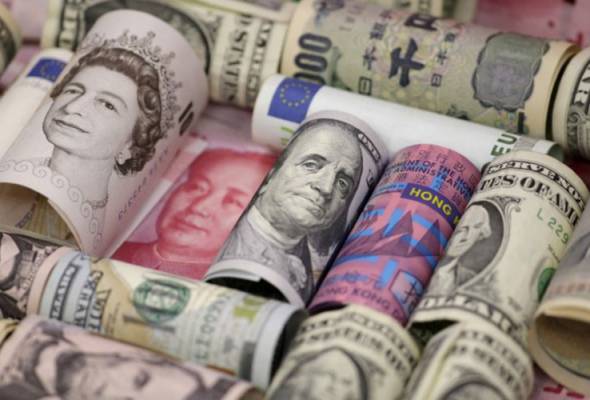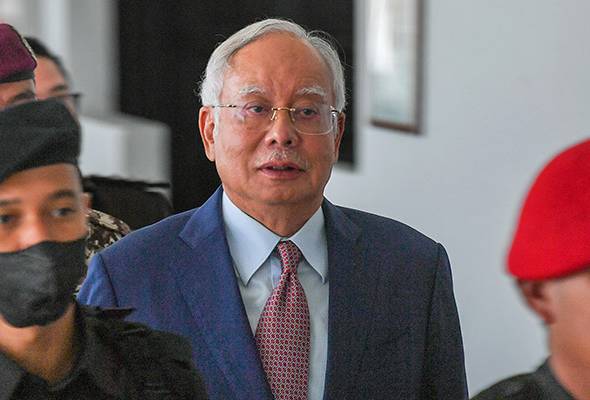
Published in BusinessToday & AstroAwani, image by AstroAwani.
It’d been somewhat inconceivable that prior to the conflict in Ukraine, the process of de-dollarisation would have gained traction at the pace and momentum which is happening now, even if the catalyst and impetus can be mainly attributed to the concerted strategic manoeuvres of the two superpowers of Russia and China.
The move by Russia to demand payments for its oil and gas in RUB (ruble) soon after the sanctions probably set in motion the accelerated drive towards de-dollarisation.
China has been an eager/enthusiastic participant from the start with an agreement to pay in yuan/renminbi (RMB) also alongside India – benefitting from the discounted prices along the way (see, “China agrees to pay for Russian gas in roubles and yuan: Gazprom”, Reuters, September 6, 2022 and “India’s oil deals with Russia dent decades-old dollar dominance”, Reuters, March 8, 2023).
Following the recent rapprochement between Saudi Arabia and Iran that was brokered by China, both countries have also agreed to accelerate the process of de-dollarisation such as the selling off of US Treasury bonds (“De-dollarization is underway as more countries seek alternatives to U.S. dollar”, CGTN, April 7, 2023).
One to one, China and Brazil have reached a deal to carry out trade and financial transactions directly in the RMB and the Brazilian real (BRL).
Whilst de-dollarisation or the process of de-coupling from the use of the USD as the world’s “reserve” currency, i.e., global intermediary of national currencies, is bound to happen sooner or later, it’s never anticipated that such multilateral re-adjustments to the international financial architecture would be fore-fronted on such a geopolitically and geo-economically significant and pivotal scale.
Yet, it has to be stressed that de-dollarisation by no means implies, definitively, that the USD will be displaced as the world’s (leading and indisputable) reserve currency soon or well into the future.
De-dollarisation is, therefore, a process and work in progress (WIP) which “end-game” (i.e., how would the diminishing status of the USD actually play out) is still very much ambiguous/nebulous and uncertain/unsettled.
The move from currency swaps and use of bilateral currencies directly in place of the USD to minimise transaction costs and promote the greater internationalisation and stature of the RMB, for example, towards the latter playing the role of equivalent rival and substitute portends multipolarity in geopolitical and geo-economic configurations.
But not necessarily the creation of parallel systems in what would be tantamount to a kind of “currency protectionism”.
The USD will still be the preferred currency of international payment settlements for many countries due to desire to accumulate financial assets from the issuer (i.e., the US) as a/the primary source of hard cash or foreign exchange (forex) earnings as determined by the balance of payments (BOP).
Thus, de-dollarisation would only mean more currency alternatives for partner countries other than the USD for convenience and ease with benefits in the “trio” of lower transaction (payment settlements), financial (forex holdings) and capital (flow of funds) costs.
A parallelism or analogy could be made with the (in)famous Mundell-Fleming macroeconomic trilemma – whereby it’s said that a country has the impossible task of maintaining/allowing capital outflow whilst maintaining monetary sovereignty/independence on the back of pegging/fixing the currency.
It can be strongly argued that Malaysia successfully defied and breached the Mundell-Fleming trilemma by refusing the Washington Consensus prescription of the World Bank (see, “Managing the Impossible Trinity: The Case of Malaysia”, Goh Soo Khoon, Munich Personal RePEc Archive/MPRA, 2009).
Something that’s not often, if at all, acknowledged.
We imposed selective capital controls (only for the short-term horizon, i.e., not more than one year).
Our currency was pegged at RM3.80 to the USD.
And we maintained monetary sovereignty/independence by ensuring that the RM became non-internationalised (i.e., non-convertible off-shore – subject to the regulations tactically imposed by Bank Negara aimed at controlling speculative activities such as the permitted thresholds and appointed offices overseas/AOOs as agents).
If this is possible, then it’s also equally possible for there to be de-dollarisation and at same with the USD maintaining/continuing its prestigious status as the world’s reserve currency (at least for a long time to come). The US could then continue on with its “exorbitant privilege” – first coined in the 1960s (under the then Bretton Woods system of gold standard exchange, i.e., the convertibility of the USD into gold) by French statesman Valéry Giscard d’Estaing (at the time, the Minister of Finance and later, President).
Unless, of course, the equation changes with the US and China exchanging places, i.e., becoming net exporter and net importer, respectively.
Even then, this still begs the question of whether such a role reversal would calm geopolitical insecurities and geo-strategic rivalries.
Would the US be contented to allow for China to assume the role which is virtually that of a “near-(neo? crypto?) hegemon” in what would be a kind of a unipolar world but that’s geopolitically “non-hierarchical”?
Will the US allow for the USD to be totally undermined given that behind the currency as a prominent national and international symbol are the values and a vision which aren’t in symmetry with China’s worldview?
In fact, it could well be speculated that the Fed’s decision to begin hiking the federal funds rate (FFR) is due to the need to shore up the USD following the move to de-dollarisation.
Notwithstanding, for the promoters of de-dollarisation (understood in contradistinction to the displacement of the USD as the world’s reserve currency), the move is also critically vital as both strategy and tactic to shield from geopolitical disruptions, a point forcefully made by President Joko Widodo (Jokowi) of Indonesia.
Last year, Indonesia rolled out a Domestic Government Credit Card programme to facilitate transactions between the central and regional administrations. The aim is for the country’s public sector and private sector to converge eventually in using a uniform payment platform for greater national security (“Top Asian economy urges citizens to abandon Western payment systems”, RT, March 19, 2023).
Prior to this, President Jokowi had called for a region/Asean-wide payment settlements connectivity to be expanded – building upon the cross-border arrangements at the bilateral level to promote a bigger impact (“Jokowi supports payment connectivity in ASEAN to enter global level”, Antara News, November 14, 2022).
Not only that, the idea (on the basis of Asean centrality) could be expanded later for jointly-developed payment system(s) at the wider regional level, i.e., in relation to the Regional Comprehensive Economic Partnership/RCEP).
In this regard, we could start with business to business (B2B) transactions first and then only move on to business to consumer (B2C) transactions later on (as the subsequent phase).
Towards that end, there should be an Asean-equivalent of a “central bank” but unlike the European Central Bank (ECB), it’ll not be as such.
But a real-time gross settlement system (RTGS) that’s like TARGET2 (Trans-European Automated Real-Time Gross Settlement Express Transfer System) which clears outstanding payments and net the respective accounts (i.e., from debit to credit).
The Asean version would simply be a regional monetary authority (limited to processing and clearing the settlement payments) – “Asean Banking System”.
In execution of the inter-bank transfers across borders, there would be a single shared platform (SSP) and, by extension, a shared/common database via multiple cloud centres (network and infrastructure diversification) to avoid/pre-empt a “single point of failure” (i.e., concentration) risk).
And which can be operated by selected (operating) central banks of the member-states on the basis of seamless operationalisation and integration in the form of inter-operable and shared interface and interchange of data, e.g.:
- Bank Negara (BNM);
- Monetary Authority of Singapore (MAS);
- Bank Indonesia (BI);
- Bangko Sentral ng Pilipinas; and
- Bank of Thailand (BOT).
For reserves by which the respective commercial banks can clear payments, the operating member-state central banks can provide the assets if need be first.
This then can be subsequently settled by the central bank under which the transactions between the commercial banks take place within the national banking system.
But normally, this isn’t necessary at all.
The operating central bank will simply serve as intermediary of the two central banks that’re the sender and receiver, respectively.
For example:
- Commercial Bank A in Brunei wishes to clear a cheque or make a deposit payment to commercial Bank B in Laos.
- But commercial Bank A is short of reserves to make the payment. Instead of borrowing from the interbank market (and the money market funds), commercial Bank A wishes to tap into the standing facility of Brunei Darussalam Central Bank (BDCB) due to a slightly lower interest rate.
- The payment settlements will then be cleared by the relevant operating central bank (under a distribution/allocation of tasks roster), e.g., BOT.
- The Bank of Laos (BOL) will then claim from BOT. In turn, the commercial bank in Laos acting on behalf of the (funds) receiver/recipient will/has a claim from BOT as the final destination of payment settlement operating route.
- So, the operating central bank will act as the centralised entity to offset and net the accounts of the sender and receiver via their respective commercial banks and, by extension, central banks (both non-operating and operating).
There’re, thus, two principal/primary components to the Asean payment settlements system:
- The Asean Banking System; and
- The banking system of the respective central banks of the member-states.
The “ancillary” (i.e., secondary) systems of the commercial banks needn’t have direct access to the Asean payment settlements system.
However, secure communications and authentication will be uniform and centralised by way of a network service provider (NSP) except that it can’t be SWIFT (Society for Worldwide Interbank Financial Telecom) for obvious reasons.
Again, this requires regional collaboration and perhaps co-headed by Malaysia and Singapore in this respect.
Currently, some commercial banks in Asean have already introduced and implemented multi-currency accounts (e.g., debit and credit cards) which should be a harbinger of greater regional integration in banking terms – reducing transaction costs such as related to forex conversions and, of course, also offering an insurance or protection against potential geopolitical (and, by inclusion, financial) risks such as sanctions and even cyber-attacks (e.g., hacking, distributed denial of service/DDOS).
Such a system will not only protect and mitigate against geopolitical fallouts and financial risks that ensue from the former.
But also enhancing the promotion of cross-border flows of funds within the Asean region as well as movement of capital (i.e., investment and trade) and workers.
Currently, Asean already has the Local Currency Settlement (LCS) scheme which allows for the facilitation of bilateral settlements which can be streamlined and made uniform across the Asean region (i.e., the same policy template for all bilateral settlements.
However, to ensure its viability, coordination and, by extension, synchronisation of the regional banking system is necessary.
Exactly like how SWIFT (Society for Worldwide Interbank Financial Telecom) was first formed back in the 1970s – where 239 banks from 15 countries got together to address cross-border payments.
Except that the Asean version combines the best of both worlds, i.e., both SWIFT and TARGET2.
Dr Rais Hussin & Jason Loh Seong Wei are part of the research team of EMIR Research, an independent think tank focused on strategic policy recommendations based on rigorous research.

